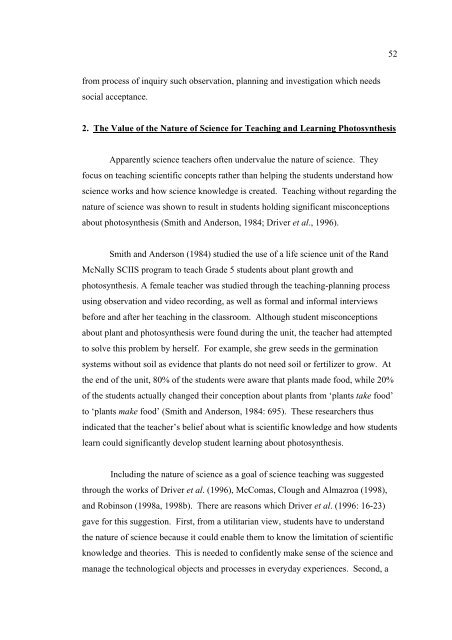an innovative approach
an innovative approach
an innovative approach
You also want an ePaper? Increase the reach of your titles
YUMPU automatically turns print PDFs into web optimized ePapers that Google loves.
from process of inquiry such observation, pl<strong>an</strong>ning <strong>an</strong>d investigation which needs<br />
social accept<strong>an</strong>ce.<br />
2. The Value of the Nature of Science for Teaching <strong>an</strong>d Learning Photosynthesis<br />
Apparently science teachers often undervalue the nature of science. They<br />
focus on teaching scientific concepts rather th<strong>an</strong> helping the students underst<strong>an</strong>d how<br />
science works <strong>an</strong>d how science knowledge is created. Teaching without regarding the<br />
nature of science was shown to result in students holding signific<strong>an</strong>t misconceptions<br />
about photosynthesis (Smith <strong>an</strong>d Anderson, 1984; Driver et al., 1996).<br />
Smith <strong>an</strong>d Anderson (1984) studied the use of a life science unit of the R<strong>an</strong>d<br />
McNally SCIIS program to teach Grade 5 students about pl<strong>an</strong>t growth <strong>an</strong>d<br />
photosynthesis. A female teacher was studied through the teaching-pl<strong>an</strong>ning process<br />
using observation <strong>an</strong>d video recording, as well as formal <strong>an</strong>d informal interviews<br />
before <strong>an</strong>d after her teaching in the classroom. Although student misconceptions<br />
about pl<strong>an</strong>t <strong>an</strong>d photosynthesis were found during the unit, the teacher had attempted<br />
to solve this problem by herself. For example, she grew seeds in the germination<br />
systems without soil as evidence that pl<strong>an</strong>ts do not need soil or fertilizer to grow. At<br />
the end of the unit, 80% of the students were aware that pl<strong>an</strong>ts made food, while 20%<br />
of the students actually ch<strong>an</strong>ged their conception about pl<strong>an</strong>ts from ‘pl<strong>an</strong>ts take food’<br />
to ‘pl<strong>an</strong>ts make food’ (Smith <strong>an</strong>d Anderson, 1984: 695). These researchers thus<br />
indicated that the teacher’s belief about what is scientific knowledge <strong>an</strong>d how students<br />
learn could signific<strong>an</strong>tly develop student learning about photosynthesis.<br />
Including the nature of science as a goal of science teaching was suggested<br />
through the works of Driver et al. (1996), McComas, Clough <strong>an</strong>d Almazroa (1998),<br />
<strong>an</strong>d Robinson (1998a, 1998b). There are reasons which Driver et al. (1996: 16-23)<br />
gave for this suggestion. First, from a utilitari<strong>an</strong> view, students have to underst<strong>an</strong>d<br />
the nature of science because it could enable them to know the limitation of scientific<br />
knowledge <strong>an</strong>d theories. This is needed to confidently make sense of the science <strong>an</strong>d<br />
m<strong>an</strong>age the technological objects <strong>an</strong>d processes in everyday experiences. Second, a<br />
52
















